Oral
Machine Learning for Data Acquisition & Image Reconstruction
ISMRM & SMRT Annual Meeting • 15-20 May 2021

| Concurrent 1 | 12:00 - 14:00 | Moderators: Mingrui Yang & Yunyan Zhang |
 |
0221.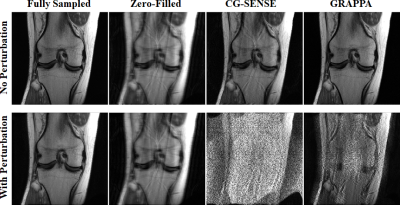 |
On Instabilities of Conventional Multi-Coil MRI Reconstruction To Small Adversarial Perturbations
Chi Zhang1,2, Jinghan Jia3, Burhaneddin Yaman1,2, Steen Moeller2, Sijia Liu4, Mingyi Hong1, and Mehmet Akçakaya1,2
1Electrical and Computer Engineering, University of Minnesota, Minneapolis, MN, United States, 2Center for Magnetic Resonance Research, University of Minnesota, Minneapolis, MN, United States, 3University of Florida, Gainesville, FL, United States, 4MIT-IBM Watson AI Lab, IBM Research, Cambridge, MA, United States
Although deep learning (DL) has received much attention in accelerated MRI, recent studies suggest small perturbations may lead to instabilities in DL-based reconstructions, leading to concern for their clinical application. However, these works focus on single-coil acquisitions, which is not practical. We investigate instabilities caused by small adversarial attacks for multi-coil acquisitions. Our results suggest that, parallel imaging and multi-coil CS exhibit considerable instabilities against small adversarial perturbations.
|
|
 |
0222.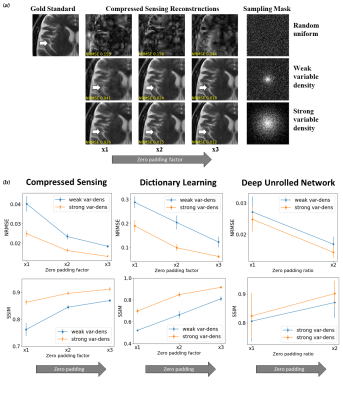 |
Subtle Inverse Crimes: Naively using Publicly Available Images Could Make Reconstruction Results Seem Misleadingly Better!
Efrat Shimron1, Jonathan Tamir2, Ke Wang1, and Michael Lustig1
1Electrical Engineering and Computer Sciences, UC Berkeley, Berkeley, CA, United States, 2Electrical and Computer Engineering, The University of Texas at Austin, Austin, TX, United States
This work reveals how naively using publicly available data for training and evaluating reconstruction algorithms may lead to artificially improved algorithm performance. We observed such practice in the “wild” and aim to bring this to the attention of the community. The underlying cause is common data preprocessing pipelines which are often ignored: k-space zero-padding in clinical scanners and JPEG compression in database storage. We show that retrospective subsampling of such preprocessed data leads to overly-optimistic reconstructions. We demonstrate this phenomenon for Compressed-Sensing, Dictionary-Learning and Deep Neural Networks. This work hence highlights the importance of careful task-adequate usage of public databases.
|
|
 |
0223.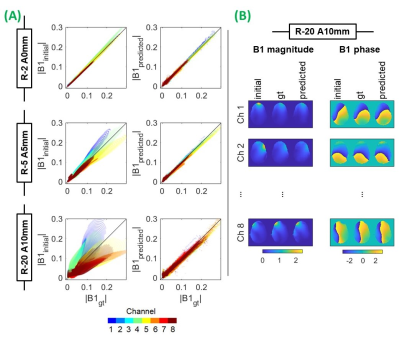 |
Motion-resolved B1+ prediction using deep learning for real-time pTx pulse-design.
Alix Plumley1, Luke Watkins1, Kevin Murphy1, and Emre Kopanoglu1
1Cardiff University Brain Research Imaging Centre, Cardiff, United Kingdom
Motion in parallel-transmit (pTx) causes flip-angle error due to dependence of channels' B1-sensitivities on head position. Real-time pTx pulse-design could mitigate motion-induced flip-angle error, but requires real-time, motion-resolved B1+ distributions (not measurable). A deep learning method is presented to estimate motion-resolved B1+ maps via a system of conditional generative adversarial networks. Using simulations, we demonstrate that estimated maps can be used to design tailored pTx pulses which yield similar flip-angle profiles to those without motion, reducing maximum observed flip-angle error from 79% to 25%. Importantly, networks can be run sequentially to accurately predict B1+ for arbitrary displacements incorporating multiple directions.
|
|
 |
0224.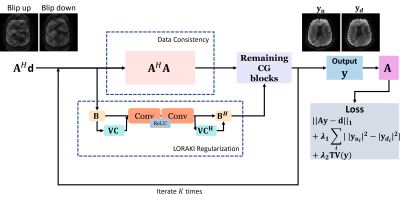 |
Robust Multi-shot EPI with Untrained Artificial Neural Networks: Unsupervised Scan-specific Deep Learning for Blip Up-Down Acquisition (BUDA)
Tae Hyung Kim1,2,3, Zijing Zhang1,2,4, Jaejin Cho1,2, Borjan Gagoski2,5, Justin Haldar3, and Berkin Bilgic1,2
1Athinoula A. Martinos Center for Biomedical Imaging, Boston, MA, United States, 2Radiology, Harvard Medical School, Boston, MA, United States, 3Electrical Engineering, University of Southern California, Los Angeles, CA, United States, 4State Key Laboratory of Modern Optical Instrumentation, College of Optical Science and Engineering, Zhejiang University, Hangzhou, China, 5Boston Children's Hospital, Boston, MA, United States
Blip Up-Down Acquisition (BUDA) has been successful in generating distortion-free multi-shot EPI (msEPI) without navigators, utilizing a fieldmap and structured low-rank constraints. Recently, a scan-specific artificial neural network (ANN) motivated by structured low-rank modeling, named LORAKI, has been proposed for refined MRI reconstruction, where its training employed fully-sampled autocalibrated signal (ACS). Although applying LORAKI framework to BUDA is beneficial, acquiring fully-sampled ACS for msEPI is not practical. We propose scan-specific unsupervised ANNs for improved BUDA msEPI without training data. Experiment results indicate that the proposed BUDA-LORAKI exhibits advantages, with up to 1.5x reduction in NRMSE compared to standard BUDA reconstruction.
|
|
 |
0225.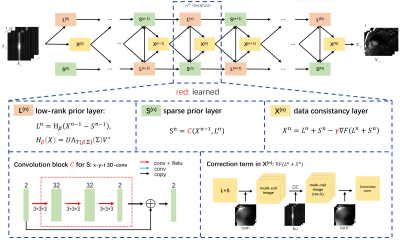 |
Deep Low-rank plus Sparse Network for Dynamic MR Imaging
Wenqi Huang1,2, Ziwen Ke1,2, Zhuo-Xu Cui1, Jing Cheng2,3, Zhilang Qiu2,3, Sen Jia3, Yanjie Zhu3, and Dong Liang1,3
1Research Center for Medical AI, Shenzhen Institutes of Advanced Technology, Chinese Academy of Sciences, Shenzhen, China, 2Shenzhen College of Advanced Technology, University of Chinese Academy of Sciences, Shenzhen, China, 3Paul C. Lauterbur Research Center for Biomedical Imaging, Shenzhen Institutes of Advanced Technology, Chinese Academy of Sciences, Shenzhen, China
In dynamic MR imaging, L+S decomposition, or robust PCA equivalently, has achieved stunning performance. However, the selection of parameters of L+S is empirical, and the acceleration rate is limited, which are the common failings of iterative CS-MRI reconstruction methods. Many deep learning approaches were proposed to address these issues, but few of them used the low-rank prior. In this paper, a model-based low-rank plus sparse network, dubbed as L+S-Net, is proposed for dynamic MR reconstruction. Experiments on retrospective and prospective cardiac cine dataset show that the proposed model outperforms the state-of-the-art CS and existing deep learning methods.
|
|
 |
0226.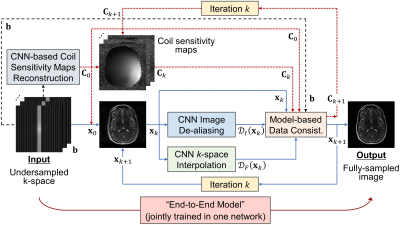 |
Joint Reconstruction of MR Image and Coil Sensitivity Maps using Deep Model-based Network
Yohan Jun1, Hyungseob Shin1, Taejoon Eo1, and Dosik Hwang1
1Electrical and Electronic Engineering, Yonsei University, Seoul, Korea, Republic of
We propose a Joint Deep Model-based MR Image and Coil Sensitivity Reconstruction Network (Joint-ICNet), which jointly reconstructs an MR image and coil sensitivity maps from undersampled multi-coil k-space data using deep learning networks combined with MR physical models. Joint-ICNet has two blocks, where one is an MR image reconstruction block that reconstructs an MR image from undersampled k-space data and the other is a coil sensitivity reconstruction block that estimates coil sensitivity from undersampled k-space data. The desired MR image and coil sensitivity maps can be obtained by sequentially estimating them with two blocks based on the unrolled network architecture.
|
|
 |
0227.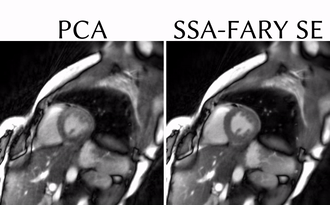 |
Ungated time-resolved cardiac MRI with temporal subspace constraint using SSA-FARY SE
Sebastian Rosenzweig1,2 and Martin Uecker1,2
1Diagnostic and Interventional Radiology, University Medical Center Göttingen, Göttingen, Germany, 2Partner Site Göttingen, German Centre for Cardiovascular Research (DZHK), Göttingen, Germany
SSA-FARY SE is a simple yet powerful novel method to estimate a suitable temporal basis for subspace reconstructions of time-series data from a potentially very small auto-calibration region. Here, we first describe the general strategy of subspace constraint time-series reconstruction. Then, we show how SSA-FARY SE can be used to estimate a suiteable temporal basis. Finally, we demonstrate its functionality by estimating temporal basis functions from the DC-components of radial spokes in single-slice and Simultaneous Multi-Slice free-breathing cardiac MRI acquisitions.
|
|
0228.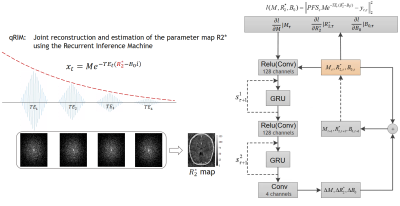 |
A unified model for simultaneous reconstruction and R2* mapping of accelerated 7T data using the Recurrent Inference Machine
Chaoping Zhang1, Dirk Poot2, Bram Coolen1, Hugo Vrenken3, Pierre-Louis Bazin4,5, Birte Forstmann4, and Matthan W.A. Caan1
1Biomedical Engineering & Physics, Amsterdam UMC, Amsterdam, Netherlands, 2Biomedical Imaging Group Rotterdam, Erasmus MC, Rotterdam, Netherlands, 3Radiology, Amsterdam UMC, Amsterdam, Netherlands, 4Integrative Model-based Cognitive Neuroscience research unit, University of Amsterdam, Amsterdam, Netherlands, 5Max Planck Institute for Human Cognitive and Brain Sciences, Leipzig, Germany
Quantitative MRI often relies on the acquisition of multiple images with different scan settings. Therefore, data redundancy can be exploited to further accelerate imaging by deep learning. We propose a unified model for joint reconstruction and $$$R_2^*$$$-mapping from sparse data and embed this in a Recurrent Inference Machine, an iterative inverse problem solving network. Applied to high-resolution multi-echo gradient echo data of a cohort study covering the entire adult life span, the error in $$$R_2^*$$$ significantly decreases. With increasing acceleration factor, an increasing reduction in error is observed, pointing to a larger benefit for sparser data.
|
||
0229.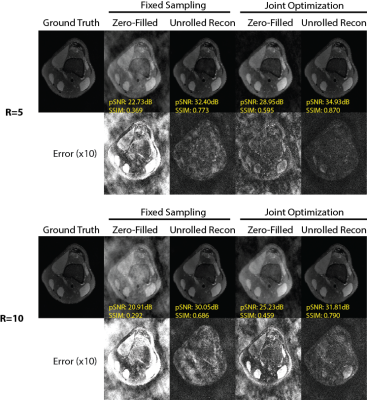 |
Joint Data Driven Optimization of MRI Data Sampling and Reconstruction via Variational Information Maximization
Cagan Alkan1, Morteza Mardani1, Shreyas S. Vasanawala1, and John M. Pauly1
1Stanford University, Stanford, CA, United States
We propose a framework for learning the sampling pattern in MRI jointly with reconstruction in a data-driven manner using variational information maximization. We enable optimization of k-space samples via continuous parametrization of the sampling coordinates in the non-uniform FFT operator. Experiments with knee MRI shows improved reconstruction quality of our data-driven sampling over the prevailing variable-density sampling, highlighting possible benefits that can be obtained by learning data sampling patterns.
|
||
0230.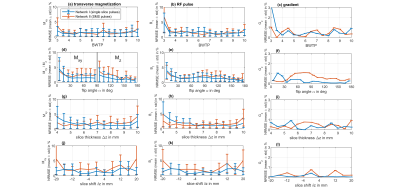 |
Design of slice-selective RF pulses using deep learning
Felix Krüger1, Max Lutz1, Christoph Stefan Aigner1, and Sebastian Schmitter1
1Physikalisch-Technische Bundesanstalt, Braunschweig and Berlin, Germany
We utilize a residual neural network for the design of slice-selective RF and gradient trajectories. The network was trained with 300k SLR RF pulses. The network predicts the RF pulse and the gradient for a desired magnetization profile. The aim is to evaluate the feasibility and dependence on different parameter variations of this new approach. This method is validated comparing the prediction of the neural network with Bloch simulations and with phantom experiments at 3T. These insights serve as a basis for more general and complex pulses for future neural network design.
|
The International Society for Magnetic Resonance in Medicine is accredited by the Accreditation Council for Continuing Medical Education to provide continuing medical education for physicians.